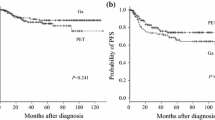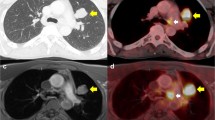Abstract
Purpose
2-Deoxy-2-[F-18]fluoro-d-glucose (FDG)–positron emission tomography (PET)/computed tomography (CT) is becoming widely available as a powerful imaging modality, combining the ability to detect active metabolic processes and their morphologic features in a single study. The role of FDG-PET/CT is proven in lymphoma, melanoma, colorectal carcinoma, and other cancers. However, there are rare malignancies such as Merkel cell carcinoma that can potentially be evaluated with PET/CT. We were therefore prompted to review our experience with FDG-PET/CT in the management of patients with Merkel cell carcinoma.
Procedures
This is a retrospective case series of six patients with Merkel cell carcinoma, 58–81 years old (average 69 ± 8.3), who had whole-body PET/CT at our institution from January 1st, 2003 to August 31st, 2005. Two patients were women and four were men. Reinterpretation of the imaging studies for accuracy and data analysis from medical records were performed.
Results
Twelve examinations were acquired for the six patients (one patient had six PET/CT, one patient had two PET/CT, and four patients had one PET/CT). The injected FDG doses ranged 381.1–669.7 MBq (average 573.5 ± 70.3). Four patients had the PET/CT as part of initial staging, and two patients had the exam for restaging (after surgery and XRT). A total of six Merkel lesions (pancreas, adrenal, lip, submandibular lymph nodes, cervical lymph nodes, and parapharyngeal soft tissue) were identified in three patients and confirmed on histopathological examination. The FDG uptake in these areas was intense, with maximum standardized uptake value (SUVmax) values of 5–14 (average 10.4 ± 3.8). In one patient, the PET/CT scan identified abnormal focal distal sigmoid uptake that was biopsied and diagnosed as adenocarcinoma. Two patients had negative scans and had no clinical evidence of disease on follow-up office visits (up to one year after PET/CT).
Conclusions
This case series suggests that FDG-PET/CT may have a promising role in the management of patients with Merkel cell carcinoma.




Similar content being viewed by others
References
Nghiem P, McKee PH, Haynes HA (2001) Merkel cell (cutaneous neuroendocrine) carcinoma. In: Sober AJ, Haluska FG (eds) Skin cancer. Hamilton, Ontario: BC Decker Inc., pp 127–141
Toker C (1972, January) Trabecular carcinoma of the skin. Arch Dermatol 105(1):107–110, January
Sidhu GS, Chandra P, Cassai ND (2005, May–August) Merkel cells, normal and neoplastic: an update. Ultrastruct Pathol 29(3–4):287–294
Allen PJ, Bowne WB, Jaques DP, Brennan MF, Busam K, Coit DG (2005, April 1) Merkel cell carcinoma: prognosis and treatment of patients from a single institution. J Clin Oncol 23(10):2300–2309
Gambhir SS (2002, September) Molecular imaging of cancer with positron emission tomography. Nat Rev Cancer 2(9):683–693
Sugawara Y, Zasadny KR, Neuhoff AW, Wahl RL (1999, November) Reevaluation of the standardized uptake value for FDG: variations with body weight and methods for correction. Radiology 213(2):521–525
Wasserberg N, Schachter J, Fenig E, Feinmesser M, Gutman H (2000, February) Applicability of the sentinel node technique to Merkel cell carcinoma. Dermatol Surg 26(2):138–141
Durani BK, Klein A, Henze M, Haberkorn U, Hartschuh W (2003, June) Somatostatin analogue scintigraphy in Merkel cell tumours. Br J Dermatol 148(6):1135–1140
Castagnoli A, Biti G, De Cristofaro MT, et al. (1992) Merkel cell carcinoma and iodine-131 metaiodobenzylguanidine scan. Eur J Nucl Med 19(10):913–916
Watanabe N, Shimizu M, Kageyama M, Kitagawa K, Hayasaka S, Seto H (1998, August) 123I-MIBG SPECT of Merkel cell carcinoma. Br J Radiol 71(848):886–887
Von Moll L, McEwan AJ, Shapiro B, et al. (1987, June) Iodine-131 MIBG scintigraphy of neuroendocrine tumors other than pheochromocytoma and neuroblastoma. J Nucl Med 28(6):979–988
Lampreave JL, Benard F, Alavi A, Jimenez-Hoyuela J, Fraker D (1998, December) PET evaluation of therapeutic limb perfusion in Merkel's cell carcinoma. J Nucl Med 39(12):2087–2090
Wong CO, Pham AN, Dworkin HJ (2000, March) F-18 FDG Accumulation in an Octreotide negative Merkel cell tumor. Clin Positron Imaging 3(2):71–73
Nguyen BD (2002, December) Positron emission tomographic imaging of Merkel cell carcinoma. Clin Nucl Med 27(12):922–923
Lin O, Thomas A, Singh A, Greenspan B (2004, November) Complementary role of positron emission tomography in Merkel cell carcinoma. South Med J 97(11):1110–1112
Yao M, Smith RB, Hoffman HT, Funk GF, Graham MM, Buatti JM (2005, April) Merkel cell carcinoma: two case reports focusing on the role of fluorodeoxyglucose positron emission tomography imaging in staging and surveillance. Am J Clin Oncol 28(2):205–210
Scanga DR, Martin WH, Delbeke D (2004, February) Value of FDG PET imaging in the management of patients with thyroid, neuroendocrine, and neural crest tumors. Clin Nucl Med 29(2):86–90
Talbot JN, Kerrou K, Missoum F, et al. (2005, August 5) 6-[F-18]Fluoro-L: -DOPA positron emission tomography in the imaging of Merkel cell carcinoma: preliminary report of three cases with 2-deoxy-2-[F-18]Fluoro-d: -glucose positron emission tomography or pentetreotide-(111In) SPECT Data. Mol Imaging Biol 1–5
Author information
Authors and Affiliations
Corresponding author
Rights and permissions
About this article
Cite this article
Iagaru, A., Quon, A., McDougall, I.R. et al. Merkel Cell Carcinoma: Is there a Role for 2-Deoxy-2-[F-18]fluoro-d-glucose-Positron Emission Tomography/Computed Tomography?. Mol Imaging Biol 8, 212–217 (2006). https://doi.org/10.1007/s11307-006-0047-2
Published:
Issue Date:
DOI: https://doi.org/10.1007/s11307-006-0047-2




